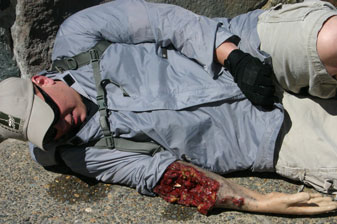Skedco Inc. is currently manufacturing the Field Expedient Bleeding Simulation System™ (FEBSS™) which is a Soldier invented and DoD owned technology. A main advantage in using the FEBSS™ is that it can be used with mannequin casualties as well as live simulated casualties. Mannequin casualties are important to education due to the fact that live simulated casualties will not tolerate certain types of treatment or conditions, such as intubation or severe in-climate weather. The FEBSS™ can be worn on or inserted into virtually any type of training mannequin, ranging from the simplest training mannequins to the more complex high fidelity mannequins that are already being used.
The FEBSS™ is a versatile and inexpensive way to train caregivers for emergency situations. It also gives caregivers the realism they need to build the muscle memory to save lives, but also the ability to act as casualties. Allowing caregivers to train as casualties gives them a better understanding of what a patient goes through while receiving treatment. The FEBSS™ is a bleeding simulator that is remotely activated at the point of wounding giving caregivers the opportunity to experience all phases of Tactical Combat Casualty Care (TC3). Once treatment is correctly applied, the bleeding wound is remotely deactivated providing the illusion that the treatment worked. The FEBSS™ also allows caregivers the  opportunity to conduct the simulation as a casualty then go back and repeat the simulation as the caregiver. These training exercises force repetition which is necessary for building muscle memory.
opportunity to conduct the simulation as a casualty then go back and repeat the simulation as the caregiver. These training exercises force repetition which is necessary for building muscle memory.
The newest addition to the SKEDCO family is the FEBSS BloodBak™. The FEBSS BloodBak™ appears to be a typical CamelBak™, but it is actually a FEBSS system in disguise. The size of the FEBSS BloodBak™ makes it a welcomed addition to virtually any type of traumatic training scenario. It is a cost effective way to bring chaos to any training event.
The FEBSS™ also provides the casualty the capability of simulating vomiting, which is a major symptom of hemorrhagic shock. The FEBSS™ utilizes a balloon line to simulate vomiting. A slice is made at the end of the balloon and the balloon is routed through a hole in the simulated casualty’s glove.
The balloon line is connected to the FEBSS™ and pressurized with fluid by making a fist when the system is remotely activated. The simulated casualty releases the balloon unleashing the simulated vomit, while simultaneously holding their hand near their mouth. The simulated casualty is then free to make vomiting noises on their own to complete the simulation.
Caregivers are able to see their buddy lying injured, bleeding, and screaming in a training exercise before they see it in an actual emergency setting. This reduces the psychological breakdown that has been proven to happen time and time again during traumatic events. Reaction time is no longer an issue. Caregivers are trained not only to treat the injury but are also being trained to work with the presence of smells, pumping blood, vomiting, and the emotions of their patient reacting to horrific pain.
Media Contact: Andy Ma Phone: (503) 691-7909 Email: andyma@skedco.com
